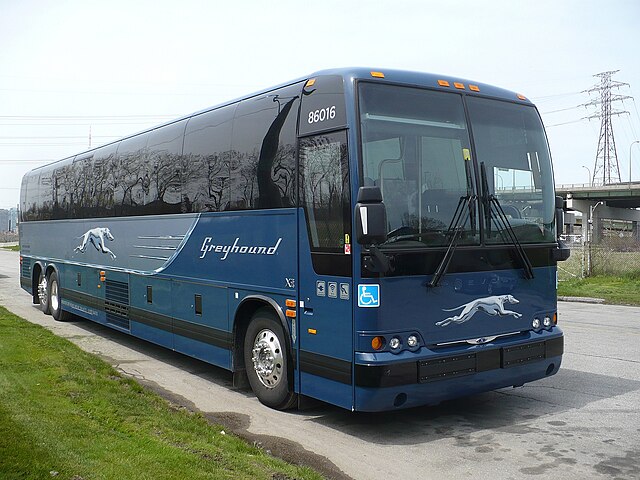In order to better compete with Megabus and Flixbus, Greyhound (which is owned by Flixbus) is selling or moving out of many of its downtown bus stations and loading and unloading passengers at curbsides. This is being derided as “taking mobility away from low-income people” and that moving stations from downtowns to suburban locations was a major hardship for passengers. But the alternative would probably be worse.
A modern Greyhound bus near Toronto. Photo by Secondarywaltz.
In 2007, FirstGroup, a British transit company, bought Greyhound for $2.8 billion plus $800 million in assumed debt for a total of $3.6 billion. Admittedly, this price included Laidlaw school buses, but Greyhound — the largest bus company in America — was the plum. Greyhound lost so much money over the next 14 years that, in 2021, FirstGroup sold Greyhound to Flix for a mere $172 million. This didn’t include the school buses or the real estate under many Greyhound bus stations, but FirstGroup remained responsible for $320 million in pension and other liabilities. Clearly, FirstGroup lost a lot of money on Greyhound.
FlixBus’s task was to turn a money-loser into a money-maker, and changing to the curbside model is a major part of this. The alternative to moving from bus stations to curbsides is to completely shut down service, which would hardly be better for low-income people. Unfortunately, members of the media are so used to seeing heavy subsidies to Amtrak, transit, and other forms of transportation that they can’t understand why the government isn’t similarly subsidizing everything else or why other modes need to earn a profit to be able to complete.
Curbside buses were pioneered in the late 1990s by Fung Wah and other Chinatown buses, and no one complained then that Chinese-Americans had to wait at curbsides. Megabus, which added internet ticket sales to the model, was patronized mainly by students, and no one complained that there was something wrong with making them board buses at curbsides.
As documented by the ChaddickInstitute, these changes transformed the industry from one that was declining to one that was growing, and traditional companies like Greyhound have to change to keep up. Ironically, Chaddick has joined the chorus of those protesting the closure o downtown bus stations.
In reality, downtowns are not as important as they once were, so having downtown bus stations does not make a bus line less accessible to low-income people as might have been true 50 years ago. Despite this, asking Americans other than Asians and students to board intercity buses at curbs instead of in stations is somehow a “humanitarian disaster.”
Until recently, Greyhound operated 230 bus stations, and they must have added significantly to its cost of doing business. Now it has to not only compete with Megabus and similar curbside companies, it is facing competition with Amtrak, which has received tens of billions of dollars from Congress for expanding service on routes that are mostly already served by Greyhound or another bus company.
The bottom line is that Greyhound moving out of expensive bus stations is far from a “rapacious business strategy” or a “municipal disgrace.” What would be a disgrace would be regulating bus companies out of existence by demanding they follow obsolete business models.









Decades ago, when I occasionally rode Greyhound in rural Michigan, bus stops included hardware stores, drug stores and other Main Street businesses. Greyhound also carried packages in competition with USPS.
Complainers should be required to take a first-year accounting class and learn about P&L and income statements.
Jacksonville Florida built a new intermodal facility, including a new Greyhound terminal to replace their previously 100% privately owned one. IIRC Greyhound has done this in Nashville and few other cities.
It wasnt The rise in telecommunications that led decline in intercity bus market. It was rise of Motel chains. With completion of Interstate motels sprung like weeds and long trips by car became palatable.
There are urbanists on X calling for Greyhound to be “nationalized.”
if you have luggage does the driver open the lower bays to put it on the bus at the curbside stops?
sthomper – Well, mostly, or at least stand there and supervise the passengers loading their own. Megabus – that darling of low-cost bus travel – runs double-decker buses that don’t have lower bays.
BTW, let’s not overlook the fact that America has a subsidized, ‘nationalized’ intercity bus line: Amtrak Thruway.